Mulching Techniques to Conserve the Soil Water and Advance the Crop Production - A Review
1
Department of Agricultural Engineering,
North Eastern Regional Institute of Science and Technology,
Nirjuli,
Arunachal Pradesh,
India
2
Department of Processing and Food Engineering,
College of Agricultural Engineering and Technology,
Godhra,
Gujrat
India
3
Department of Irrigation and Drainage Engineering,
College of Agricultural Engineering and Post Harvest Technology,
Ranipool,
Sikkim
India
DOI: http://dx.doi.org/10.12944/CWE.15.Special-Issue1.02
Copy the following to cite this article:
Prem P, Ranjan P, Seth N, Patle G. T. Mulching Techniques to Conserve the Soil Water and Advance the Crop Production - A Review. Curr World Environ 2020; Special Issue (Sustainable Mining). DOI:http://dx.doi.org/10.12944/CWE.15.Special-Issue1.02
Copy the following to cite this URL:
Prem P, Ranjan P, Seth N, Patle G. T. Mulching Techniques to Conserve the Soil Water and Advance the Crop Production - A Review. Curr World Environ 2020; Special Issue (Sustainable Mining). Available from: https://bit.ly/2V1mlAt
Download article (pdf)
Citation Manager
Publish History
Select type of program for download
| Endnote EndNote format (Mac & Win) | |
| Reference Manager Ris format (Win only) | |
| Procite Ris format (Win only) | |
| Medlars Format | |
| RefWorks Format RefWorks format (Mac & Win) | |
| BibTex Format BibTex format (Mac & Win) |
Article Publishing History
| Received: | 09-05-2020 |
|---|---|
| Accepted: | 15-06-2020 |
| Reviewed by: | 
 Mohammad Mehdizadeh
Mohammad Mehdizadeh
|
| Second Review by: |

 Divyesh Varade
Divyesh Varade
|
| Final Approval by: | Dr Umesh Kulshrestha |
Introduction
It is becoming increasingly clear that the challenge of feeding tomorrow’s population is to an outsized extend about improving productivity of water within present land use, as new arable land is relatively limited (Prem et al., 2017). Agriculture sector consumes the highest quantity of water in the world around 70% of total usage (Qin et al., 2018). In which, 80% of global cropland is covered by non-irrigated (rain-fed) that contributes 60–70% of the world's food production (Chen et al., 2018). Bearing in mind the rising water scarcity, rain-fed cultivation plays a vital role in the global food supply (Sun et al., 2012; Li et al., 2017). Contrarily, global warming and asymmetrical rainfall outlines are answerable for the lack of water resources which bound agricultural production in arid and semi-arid areas (Qin et al., 2015; Li et al., 2017). Thus, to save water in cultivated land, agriculture water management is a key concern. Also, in dryland farming rain-fed cultivation is being stressed which needed more effective consumption of water resources by using water-saving technologies (Qin et al., 2013). Therefore, in arid and semi-arid regions of the world, conservative and efficient water-use has been functioned for many years with huge success. Maximizing yield with minimizing water usage is the leading target of every water conservation systems. The effective usage of water is decisive aspect during crop growth stages which can significantly advance yield (Kader et al., 2019). Insufficiency of water is the major concern for the country now a days because the water resources are contaminated with pollutants day by day and usable water is declining. Also, the health of soil is declining vigorously. Therefore, what are the options to break out from these situations? What should have to do to save the moisture content of soil body? What can we do to reestablish the soil’s healthiness? What should have to do to stop the weed growth and restrict its germination in the soil? What can we do to feature nutrients to soil body? What can we do to take care of a decent micro-flora and maintain a well steadiness of soil’s micro-organisms? The reply is simple, to implement the exercise of mulching in agricultural fields. Therefore, mulching could be an effective choice for saving water along with increasing production in rain-fed or dryland farming. The word mulch has been originated from the German word “molsch” means soft to decay, which seemingly denoted to the use of straw and leaves by gardeners as a spread over the ground as mulch (Jack et al.,1955). Therefore, mulch is frequently defined as any material applied as cover to the soil surface. Mulch is defined as a coating material spread over the soil surface (Kasirajan and Ngouajio, 2012). Mulching is an important cultural practice that can lessen the quantity of work essential in gardening, helping to produce healthier plants and potentially growing vegetable produces. Mulching is the exercise of protective covering of the soil surface around the plants with a living or non-living mulch to make promising conditions for the plant growth and efficient crop production (Chakraborty et al. 2008; Kader et al., 2017a). It shields soil to protect organisms and plant roots from diverse meteorological conditions. Mulching optimizes water use and helps to advance crop development along with yield (Yu et al. 2018). The principal objectives of mulching are controlling erosion and saving water in low rainfall regions. While natural mulches such as leaves, straw, tree waste, grass clippings, bark clippings and compost have been used for centuries, during the last 60 years the arrival of synthetic materials has changed the means and profits of mulching. There is so much resources available on effect of synthetic mulches make a huge volume of valuable works. Comparatively plastic mulches are fully impermeable to water. Therefore, it confines the losses of water and erosion of soil through-out the soil surface by preventing rapid evaporation from the surface of soil and the upsurge of water comprising salt, which is important in countries which has high salt content water resources. In this way it plays a productive part in conserving water (Sharma and Bhardwaj, 2017). Thus, it enables more withholding of soil moisture and assistances in control of temperature variations, advances physical, chemical and biological properties of soil, because it can augment nutrients to the soil and eventually augments the advance and harvest of various crops (Dilip et al., 1990). In addition, mulch can excellently diminish water vapour loss, weed problems soil erosion, and nutrient loss (Van Derwerken and Wilcox, 1988). Mulching can be divided generally into two groups–organic and inorganic. Also, natural and synthetic mulching is other types. Organic mulches like tree barks are generally a descendent of various timber industries, which decay willingly on time. Inorganic mulches like plastic films do not decay rapidly and may essentially persist in the atmosphere to an unspecified period of time. Most categories of mulches are accessible by the container. It’s best to spread on organic mulch just after buying or distribution. If it is no convenient to do so, cover the mulch with a tarp or plastic to keep the material dry. The assortment of mulches hangs on accessibility, rate, appearance, quality, and resilience. Understanding the features of various mulching materials and their proper usages may assistance you to hand-picked the correct mulch as per requirements.
Benefits of Mulching
Mulching improvises soil productivity, soil ventilation around the plant, aggregates the soil particles and drainage of excess water (Kader et al., 2017a). There is a lot of benefit of mulching in crop fields like reduction in loss of soil water, soil erosion, growth of weeds, kinetic energy of water droplets and competition between the surrounding fields for nutrients and water (Tarara, 2000; Yang et al. 2015; Kader et al. 2017a). Mulch can be helpful in improvising soil structure and steering of nutrients due to movement of earthworm into the soil (Qin et al. 2015). It also let down the soil pH which augments availability of nutrients. Organic mulch adds nutrients in the soil after break down and increases the availability of nutrients for long time within soil (Larentzaki et al. 2008). Plastic mulch entertains as impermeable to the gassy movement which act as a greater wall for the process of solarization and fumigants. It can also show an astonishing role in increasing soil health and control of pests (Chalker-Scott, 2007). Consequently, it supports in keeping the nutrient around the root of plant for effective use of nutrient and also helps in reduction of leaching of fertilizer. The uniformity in look all over the mulched landscape are more appealingly (Li et al., 2013; Chen et al., 2018). Furthermore, in the different stages of growth of crops there is a viable changing in the appropriateness of soil moisture and temperature. After decomposition of organic mulch in the soil, the organic material of soil enhances rapidly and consequently increases the water holding capacity of the soil (Kader et al., 2017c). Some other benefits are described below:
- Moisture retaliation in the root zone: Due to slow down in evaporation done by mulches, more moisture is being available nearby the plant roots and also more time available for plants to take the water. So, area covered with mulch requires less application of water (Ranjan et al, 2017).
- Soil structure improvement: Organic mulches as well as bio-degradable plastic mulches ultimately collapse and augment nutrients to the soil surface, improvement in moisture retention capacity and increment in the humus layer.
- Soil temperature stabilization: The fluctuation in temperature is governed by mulches in the plant’s root zone, which resulted in the cooler soil in summer and warmer soil in winter season.
- Weed management: Mulch reduces the germination of seed by preventing sun light to reach the top layer of soil. Weeds are also prevented to germinate by plastic films and landscape fabrics after forming a protective layer on the soil (Sharma and Bhardwaj, 2017).
- Reduction in reflectivity: The heat and light are reflected by sand and clay soils beneath the leaves of plant. Less reflection of light is observed in organic mulches due to its multifaced and darker faces. Thus, rate of evaporation is reduced by organic mulches. But reflectivity is increased by inorganic mulches specially rocks, which is suitable for some plants but harmful for more sensitive plants (Kader et al., 2019).
- Erosion control: Mulch reduces the kinetic energy of rain and slow down the movement of rain water, which averts runoff and giving the soil more time to absorb the rain water. The supplementary moisture cheers growth of plant roots, which further results into the stabilization of soil. Mulch also protect soil from wind erosion (Ranjan et al., 2017).
- Reduction in maintenance: Less intercultural operation required in the mulched area due to less weed growth.
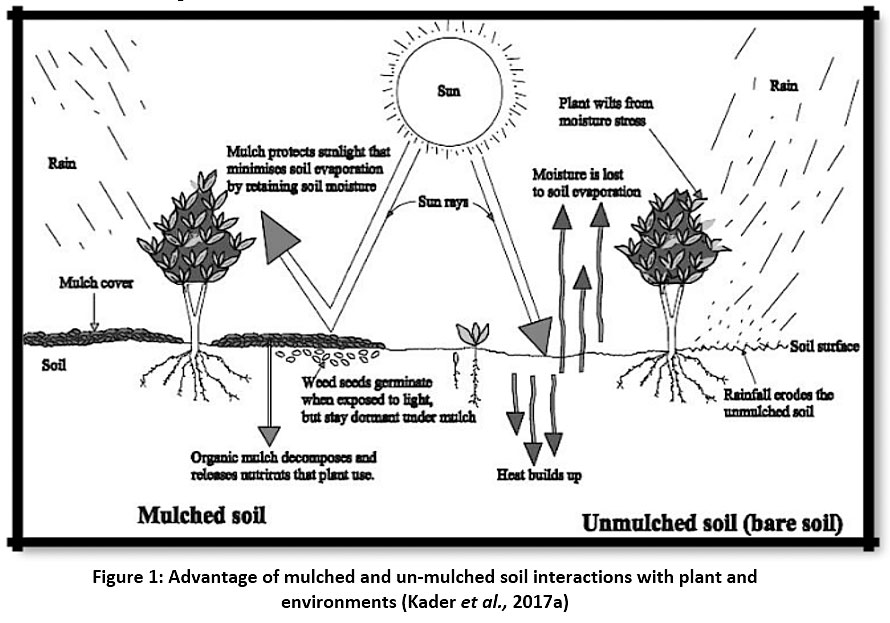 |
Figure 1: Advantage of mulched and un-mulched soil interactions with plant and environments (Kader et al., 2017a) Click here to view Figure |
Drawbacks of Mulching
There are also some negative impacts of mulching such as more labor requirement, higher transportation charge, removal and disposal problems etc. The plastic mulch has close contact with the soil which results into the production of fragment and contamination of soil (Steinmetz et al., 2016). Growth of weeds and release of acid into the soil is also main problem of some organic mulching material such as straw and grass (Chalker-scott, 2007; Patil et al., 2013). Mulched soil consisting better aeration of soil, higher temperature and constant moisture content tend to favor the higher microbial activity in the soil which refers to more complete nitrification in the soil which is treated with mulching (Huang et al., 2008). The plastic film wreckages disposed and buried by farmers in cultivable sheet of the soil through on-site burning and landfilling which leads to severe soil contamination and reduced crop growth (Gonzalez et al., 2014).
Application criteria for mulches
The crops you grow and the location of your field will determine the time of application of mulching. Some important guidelines are described below:
- Crop growing season: The crops grow in cool season, like peas and spinach, can be mulched early but crop grows in summer season, like corn and tomatoes, cannot be mulched until the soil gains higher temperature unless black plastic film is used in mulching. In spring season mulching is done after little dry up of soil.
- Cold season protection: A common misapprehension is that mulching is done to prevent freezing of soil. Water temperature should not be permitted to go far below fir acceptable biochemical oxidation of organic (Ranjan and prem, 2018). Mulch permits soil to heat up progressively in spring and useful for the early germinated plants which germinates early before soil temperature is warm sufficient to tolerate them. In the spring season when new growth of plant is observed at the base of protected plant, then winter mulch should be removed.
- Trees and shrubs: To avoid compaction of soil and root suffocation nearby the foot of shrubs and trees, not more than 2-3 inches layer of mulch should be applied. Avoid supporting mulch against stems and trunks of plants. Over mulching resulting in constant moisture availability may also lead to promote the growth of bio-organisms or various pathogens and build a home for unwanted and dangerous insects and pests (Ranjan et al., 2017).
- Vegetable production: Mulching the vegetable garden guards fruits and vegetables from being streaked by soil, conserves moisture, lessens rivalry from weeds and also reduces the spread of hazardous pathogens. Mulch must be applied subsequently soil has warmed. In vegetable gardens, mulch might be applied to make alleyways between plant rows for easy inter-culture operation and harvesting.
- Recently seeded lawns: In newly seeded lawns, mulching is used to save seeds from washing away, protects from birds and rodents and keeps moisture for better germination. Clean barley, oat or wheat straw is suggested as an alternative because it is generally free from seeds instead of hay because it often comprises of weed seeds.
- Weed management: Mulching should be done before weeds start rising to control the weeds. Hoeing or pulling should be done before mulching when weed starts growing. The thickness of mulch layer should be enough to control weeds but not thicker that it become harmful for plants. The density of mulch material, aeration of soil and type of plant decides the proper thickness of the mulch. Commence with a mulch layer around 2 inches thick and top up with more mulch as it collapses. Mulch should be at least 4 inches away from the stems of plant (David, 2002).
Classification of Mulches
(A) On the basis of organic matter- Organic mulches: Organic mulches can be made of naturally occurring various substances which contains organic matter in it. Common examples of organic mulching are bark clippings, grass clippings, compost, dry leaves etc.
- Inorganic mulches: Inorganic mulches made up of inorganic substances which does not contains organic matter in it. Inorganic mulches include stones and gravels, polyethylene films, landscape materials and rubbers.
- Natural mulches: Natural mulches are generally made up of naturally occurring materials. Organic mulches are also known as natural mulches. No prerequisite for replacement of natural mulches because it decomposes readily.
- Synthetic mulches: Synthetic mulches are made of artificial non-living substances. Various types of synthetic mulch materials are available in market for use in crop fields such as plastic films, plain and oiled paper, spun materials etc.
- Surface mulching: When mulches are spread on the soil surface in order to lessens the evaporation rate and increase the moisture holding capacity of soil, then it is called as surface mulching. In rain-fed farming, surface mulching is broadly used as water conserving practice (Chakraborty et al. 2008; Zribi et al. 2015).
- Vertical mulching: It is the soil treatment which is conducted near the root system of tree’s in order to improve the root function and health of tree by ventilating the compressed soil, increasing water retaining power of soil, advancing infiltration capacity of soil and adding nutrients to the soil. Vertical mulching commonly known as composting. It is conducted by digging of 30 cm deep and 15 cm wide trenches across the slope at interval of 2 to 4 m and adding some organic materials like grasses, straws, stubbles etc. (Telkar et al., 2017).
- Growing Vegetative Barriers: Subabul and Glyricidia plants are planted on the contour lines as vegetable barriers in order to serve as a mulch, which can improve the moisture holding capacity of soil (Patil et al., 2013).
Organic Mulches
Organic mulches comprise of materials like animal compost, grass clippings, straw of various crops, dried leaves, tree bark clippings and saw dust. It has easily degradable capacity because nature of appealing slugs, insects and worms that eat them and help them in rapid degradation, which results in addition of some quantity of nutrient and organic material in the soil. Organic mulch has a large number of helpful features. Some of them are: soil moisture conservation by reducing the rate of evaporation, moderates soil temperature, lessens soil erosion, hinders growth of weed, cheers the growth of beneficial soil bio-organisms, and diminishes the blowout of soil-borne pathogens. Organic mulches after decomposition over time improve soil structure and increase nutrient content of the soil (Telkar et al., 2017). The illustration of different organic mulches and their usages are given below:
(A) Bark clippings: Bark clippings (shown in Figure 2) are long lasting materials and permit appropriate aeration to the soil. It can be used properly in dry as well as wet regions and having more water holding capacity. In wet region, if rain is too much the wood bark will reduce waterlogging condition after absorbing the excess water and if rain is too little, the wood bark will release the holding water, providing water to the plants in dry times also.- Bark (hardwood): Hardwood bark clipping is the derivative of paper and timber industries and differs in sizes ranging from chips to bigger nuggets. It is mostly used nearby the shrubs and trees. Both coloured and natural varieties of bark is obtainable. Colored varieties are generally a mixture of recycled wood waste comprising non-natural peroxides. Hardwood bark clippings having more nutrients than soft wood but bark clippings are not effortlessly and plentifully available (Ranjan et al., 2017) and also phytotoxicity is caused by some bark products (Telkar et al., 2017). These barks are slightly alkaline in nature (Ranjan et al., 2017).
- Bark (softwood): It is similarly a derivative of wood and paper industries. The common example is pine bark and it is commonly used under large shrubs and trees. It is somewhat acidic in behavior, takes more time to decay. These barks are obtainable in several sizes and generally applied to 2 to 4 inches of depth (Ranjan et al., 2017).
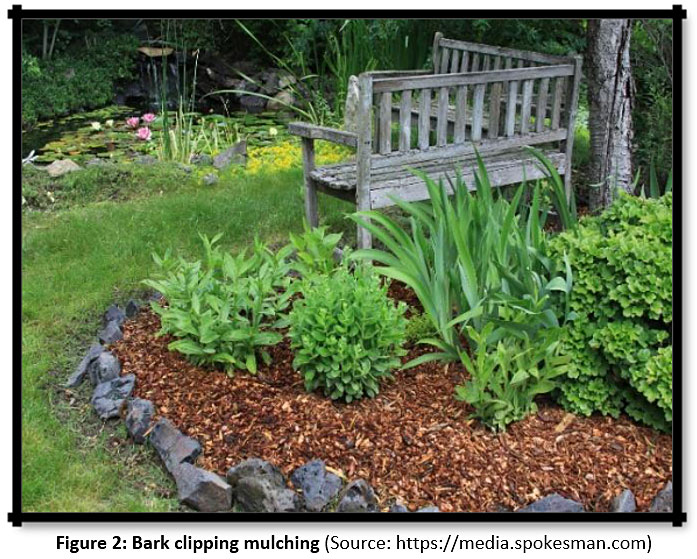 |
Figure 2: Bark clipping mulching Click here to view Figure |
(B) Tree waste: Generally, this mulch (shown in Figure 3) outcomes from larger lumps of timbers. At the time of decomposition, the fresh tree chunks will utilize larger sums of nitrogen inside the soil. This type of mulch is specifically useful for making pathways (Telkar et al., 2017).
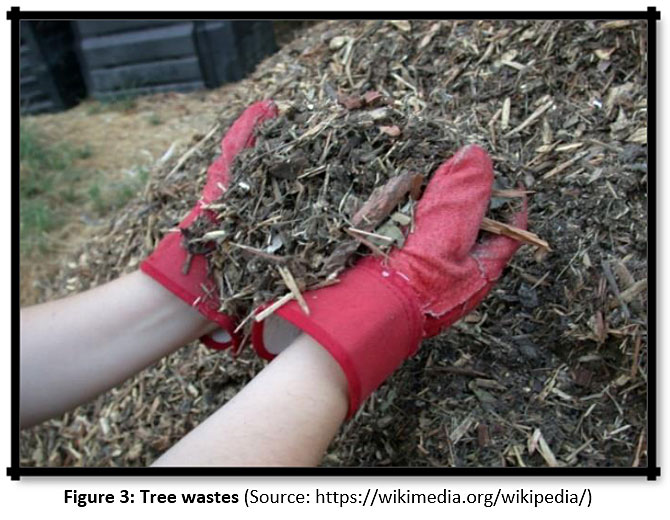 |
Figure 3: Tree wastes Click here to view Figure |
(C) Leaf mulch: Leaves are decent for mulching which is easily and profusely available (Ranjan et al., 2017). However, leaves are good for shielding inactive plants during winter season by keeping them warm and it helps in starting germination throughout winter season but they may be blown away even by little speed of wind due to its light weight. Bark, stone or any other material which are useful in reducing wind speed, should be used to lessen these problems (Patil et al., 2013). It can be made at home by composting shredded leaves. Leaf mulch (shown in Figure 4) can be used in all types of gardens. Leaves infected with disease should be disposed instead of composting (Telkar et al., 2017). Proper thickness of the leaf mulching is about 3 to 4 inches (Ranjan et al., 2017).
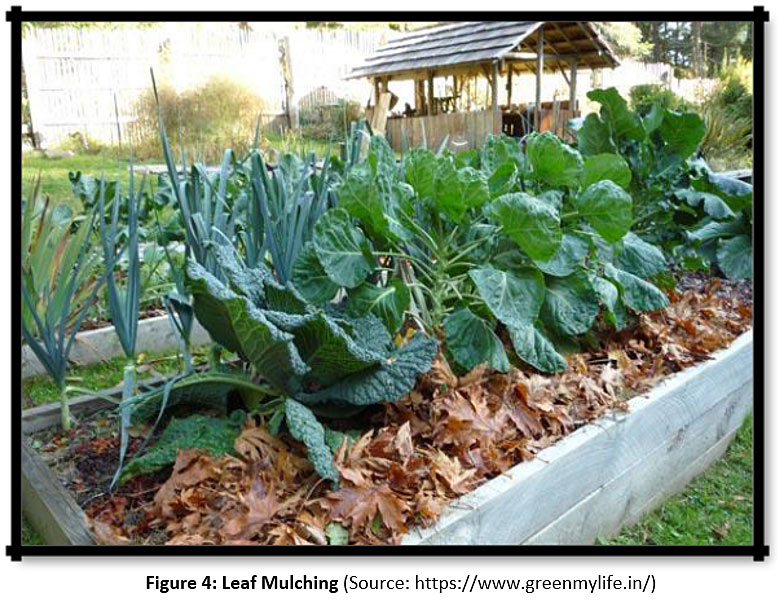 |
Figure 4: Leaf Mulching Click here to view Figure |
(D) Grass clippings: Grass clippings (shown in Figure 5) are effortlessly and profusely available mulch materials in agriculture. It provides some quantity of nitrogen and organic material into the soil if freshly incorporated in the soil. If green grass clippings added in the soil, it can develop its root system it can create damage to growth and development of crops. So, use of dry grass is more favorable as mulch material (Telkar et al., 2017, Patil et al., 2013). Grass clippings should be spread in thin layers for better result across perennial and vegetable beds and concave at the end of the growing season. Before adding extra layers let every layer to dry. Grass clippings will mat if thick layer of clipping is applied instead of thin layers. Grass clippings taken from lawns which is treated with insecticides or herbicides never be used. It should apply at a depth of 2 to 3 inches (Ranjan et al., 2017).
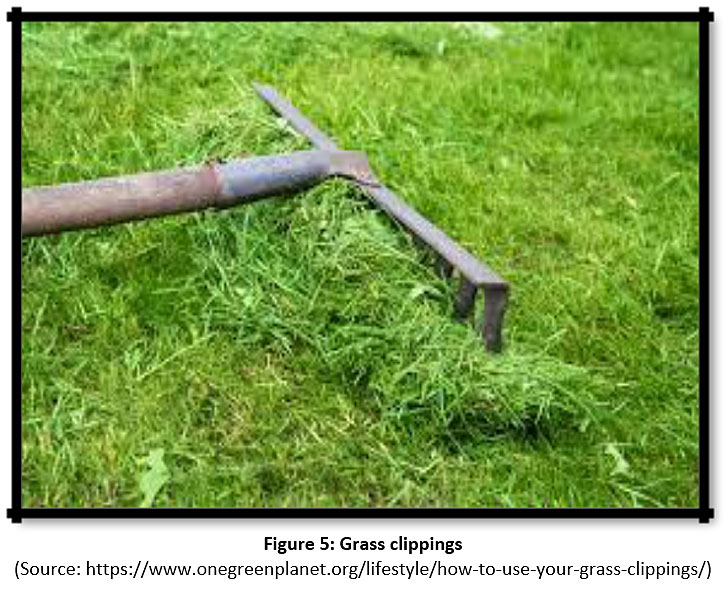 |
Figure 5: Grass clippings Click here to view Figure |
(E) Composted animal manure: The composted animal manure (shown in Figure 6) is an excellent choice for mulching material which advances the soil health, increases the population of microbes or bio-organisms and adds nutrients to the soil. Compost is slightly acidic in nature. Compost does not have better capability of weed suppression which is one noticeable drawback of composted animal manure (Telkar et al., 2017). Use of fresh manure in crop field sometimes results into burning of plant roots. Before using as a mulch manure should be well decomposed at temperatures between 54°C to 60 °C for minimum one week and 4 to 6 months composting to eradicate potential disease micro-organisms. The manure of pigs, cats and dogs should never be added to vegetable crop. It is too used as a mulching material in various nutrient consuming florae alike roses. 3-4 inches of depth is favorable for compost using as a mulch (Ranjan et al., 2017).
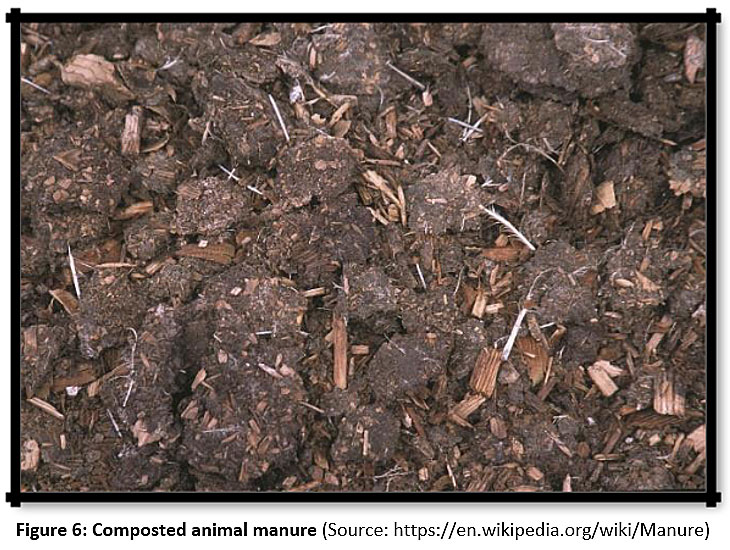 |
Figure 6: Composted animal manure Click here to view Figure |
(F) Newspaper: Newspaper mulching (shown in Figure 7) is helpful in adding some organic matter into soil and controlling weeds. Thickness of 1 to 2 cm of newspaper sheet is required for mulching and the edge of paper should be fastened with stones, gravels, pebbles etc. Suppression of weed is done by the layers of white and black newspapers (Patil et al., 2013). Apply 2 to 3 layers of newspaper at a time and cover it with leaf mulch or grass clippings or any other organic materials so that it cannot blow away by the winds. Newsprint will ultimately decay and can be merged into the soil.
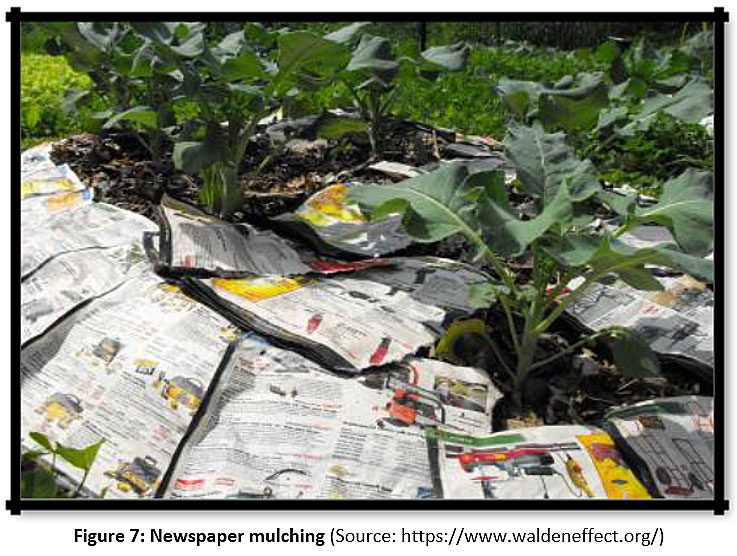 |
Figure 7: Newspaper mulching Click here to view Figure |
(G) Straw mulches: Some examples of straw mulches are groundnut shells, cotton shells, Straws of paddy and wheat, crop stubbles etc. which are used as mulches for moisture conservation on soil surface. Even nutrient content is less in straw but soil converts more productive after decomposition of straw mulches. Straw mulches (shown in Figure 8) reduce amount and rate of evaporation and lessen the amount of energy captivated by the soil (Telkar et al., 2017).
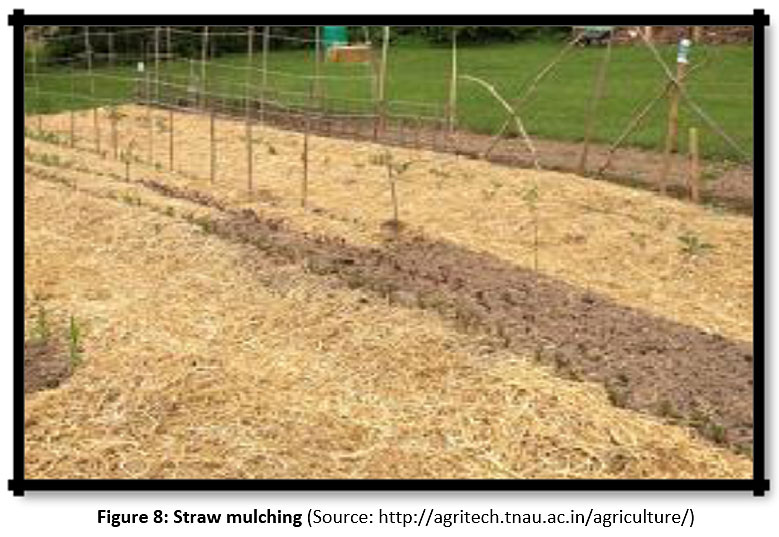 |
Figure 8: Straw mulching Click here to view Figure |
(H) Sawdust: Sawdust (shown in Figure 9) is obtained from wood and furniture making industry and very deprived in nutritive value. It is slowly decomposable. It is acidic in nature so it should not be used in acidic soils.
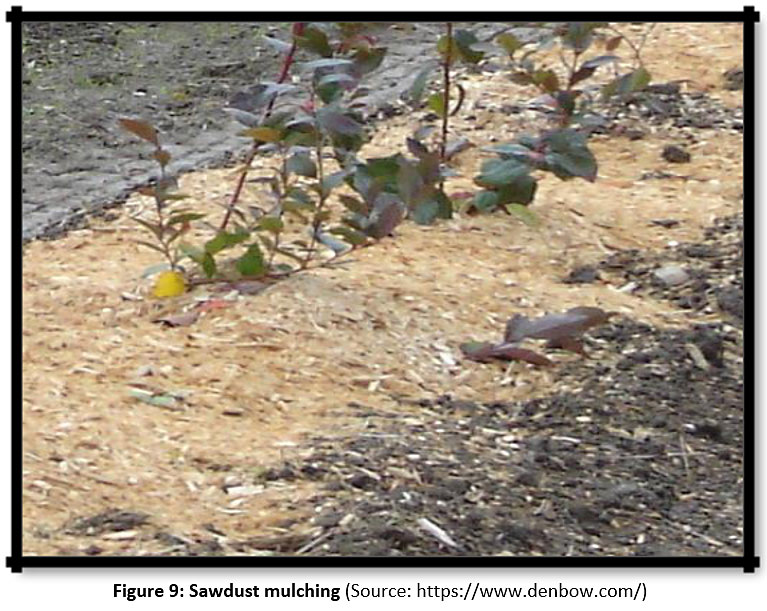 |
Figure 9: Sawdust mulching Click here to view Figure |
Benefits of Organic Mulching
A vital role is played by organic mulch in reflecting solar radiation. It reduces rate of evaporation and keeps soil cooler. Prevent germination and growth of weeds, lessens erosion of soil, reduces runoff, increase moisture retaining power of soil, improves infiltration and percolation of water, advances the soil condition, make soil porous and augments better growth of roots. It can also maintain the soil temperature.
Drawbacks of Organic Mulching
Mulches restricts oxygen supply nearby the root region of poorly drained soil because more moisture retains due to mulching. Surrounded moisture in stem of the plant can create habitat for various microorganisms, pests and diseases, if mulching is done close to the stem. Mulches like grass clipping, straw, hay etc. having seed can encourage germination of weeds.
Inorganic Mulches
Inorganic mulches are commonly used to create obstruction in germination of weeds and also used for decoration. Inorganic mulches like stones, gravels and rocks does not decomposes voluntarily, so they do not participate in improving soil condition but bio-degradable and photo-degradable plastic mulches are readily decomposable and improve the soil condition as well after decomposition, because they are made from plant sugar or starches. Heat can be absorbed and reflected by rocks which are useful in dry and hot environmental condition.
Advantages of Inorganic Mulching
Inorganic mulches are cost efficient because they cannot replace frequently, more durable compared to organic mulches because they do not decompose early, conserving soil moisture, save the time, control weeds, maintain the soil temperature, prevents attack of insects and diseases and solarize the soil.
Drawbacks of Inorganic Mulching
Inorganic mulches, except in biodegradable plastic mulches, do not augment any nutrient to the soil because they do not decompose. In several cases inorganic mulch will get damaged by sun in several cases and starts looking damaged with time. It can increase temperature of soil if established in large areas. Inorganic mulches like rubber may create harm to plants as it is toxic in nature.
Inorganic Mulches Material
The illustration of different inorganic mulches and their usages are given below:
- Landscape fabric: Landscape fabric is a better option to overpower weeds for a long time because it permits water and air to pass through it. It can also crumble more quickly than most of the other inorganic mulches when it is used in combination with organic mulches. Landscape fabric is generally made up of polypropylene web of high strength and it acts as a stretchy open-weave textile. It can also control the soil erosion and protect the soil from wind and water erosion, when it is used beneath a layer of mulch. It allows drainage of rain water through it into the soil, which is not possible in plastic films. Landscape fabric is more preferable than plastic films most of the time.
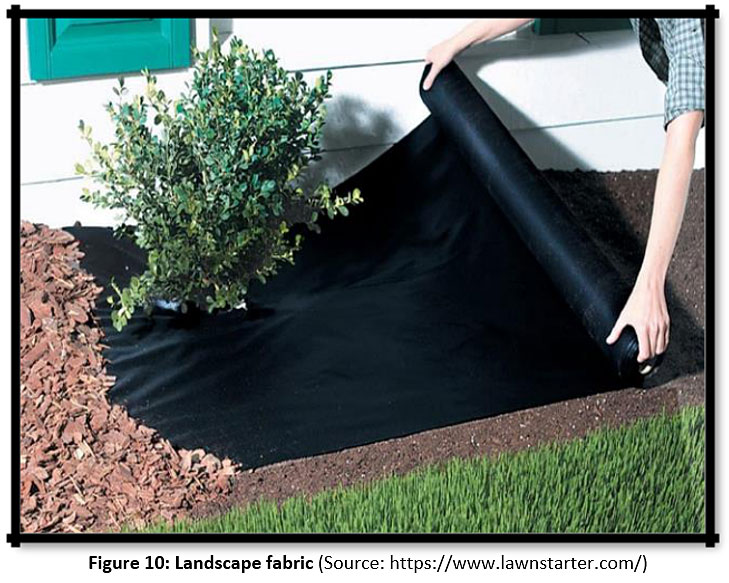 |
Figure 10: Landscape fabric Click here to view Figure |
- Stones and gravels: Stones and gravels are used successfully in dryland fruit cropping. It can lessen evaporation rate, rise infiltration rate and prevent germination of weeds. solar radiation is echoed by stones, that can create very hot soil atmosphere during hot season. So, it should be used away from trees and other plants.
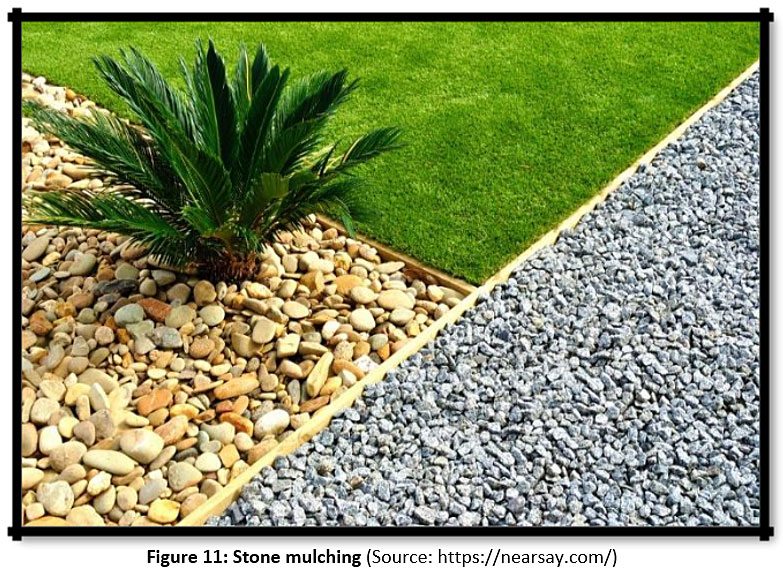 |
Figure 11: Stone mulching Click here to view Figure |
- Rubber: Rubber mulch is made from recycled rubber or tires. It has toxic substance in combination, having more risk of flammability and can remain in the soil for indefinite period. It is not suggested to use in home gardens. Rubber mulch does not absorb nutrients or water, effective in controlling weeds, does not decompose or misplace by wind, extremely cost effective and discourages insects and pests development.
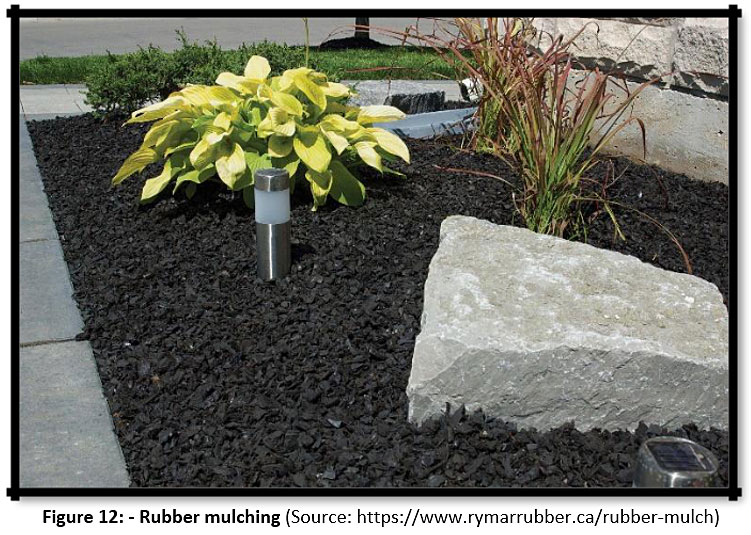 |
Figure 12: - Rubber mulching Click here to view Figure |
- Plastic mulch: Plastic mulches are very useful and effective in controlling rate of evaporation. Water and nutrient cannot pass through plastic film because it is impervious in nature. Plastic mulch is best suited for vegetable gardens to increase the temperature of soil in spring season. It is not advisable to use for long period and generally used for only one season because it deteriorates with exposure to sunlight. In plastic mulching, both types of colored and clear or transparent films are used. Plastic mulches like biodegradable and photodegradable mulches comprises of optical properties which is used for definite crop in a specified location (Steinmetz et al., 2016). It should be used for specific crop after understanding the optimum environment around the ground.
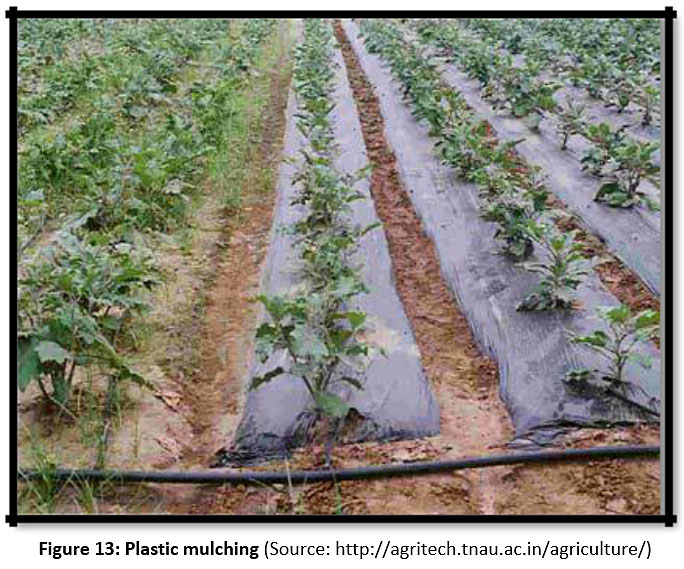 |
Figure 13: Plastic mulching Click here to view Figure |
Types of Plastic Mulches: -
Colored Mulches
With the appropriate assortment of plastic mulch composition, thickness and color, soil environment can be accomplished exactly. Many color mulch films are available including red, white, black, silver, clear or transparent etc. But the selection of the color hinge on definite targets. Different types of colored mulches are described below:
I. Single colored mulch films:- White: Cools the soil better than all available colors.
- Red: Increases vegetative production of many crops.
- Black: It is very helpful in soil moisture conservation, reducing weed growth due to lack of photosynthesis beneath the film, economical in use and does not permit the entry of sunlight through it.
- Yellow/ Black: Work as ambush for various insects and pests
- White/ Black: Cool off the soil
- Silver/ Black: Cool off the soil but not more than white/black film and prevent attack of some aphids and thrips.
- Red/ Black: Partially translucent in nature allowing some solar rays to lead through it to warm up the soil and reflect some radiation back to plant canopy, which results in vegetative growth, better development of flowers and change in metabolism to increase the production and reduce the time of fruiting in some vegetable and fruit crops.
- Blue/ Black: Restricts reflections of radiation.
Clear or transparent mulches
It is used to solarize and increase the temperature of soil.
Reflective silver film
It usually keeps cool the temperature of root zone.
Metalized mulch film
It delivers extra light to the plant and reflect a range of light which can partially discourage the white flies and aphids to spread disease.
Infra-Red transmitting mulch film
IRT (Infra-Red transmitting) plastic mulch films are available in different colors from green to brown hues. The light is permitted to pass through the soil bed after getting filtered from the colored films. These films are effective in controlling of weeds and increasing the temperature of soil.
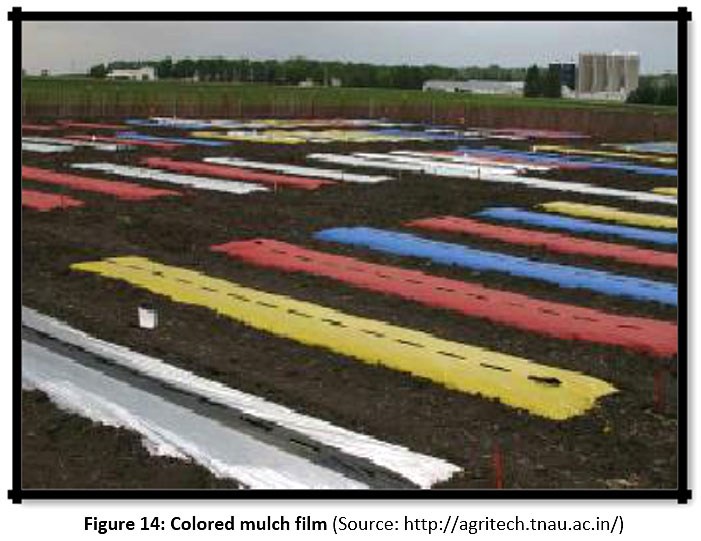 |
Figure 14: Colored mulch film Click here to view Figure |
- Degradable mulches
b. Bio-degradable plastic mulch: It is primarily made from polyester fibers, plant sugars, starches or firewood resources which can come from maize and wheat plants. It gets easily decomposed under natural environmental conditions and gets mixed in soil after mulching period (Divya and Sarkar, 2019). The biodegradable mulches were prominently thinner than the photodegradable mulches (Hannan, 2012).
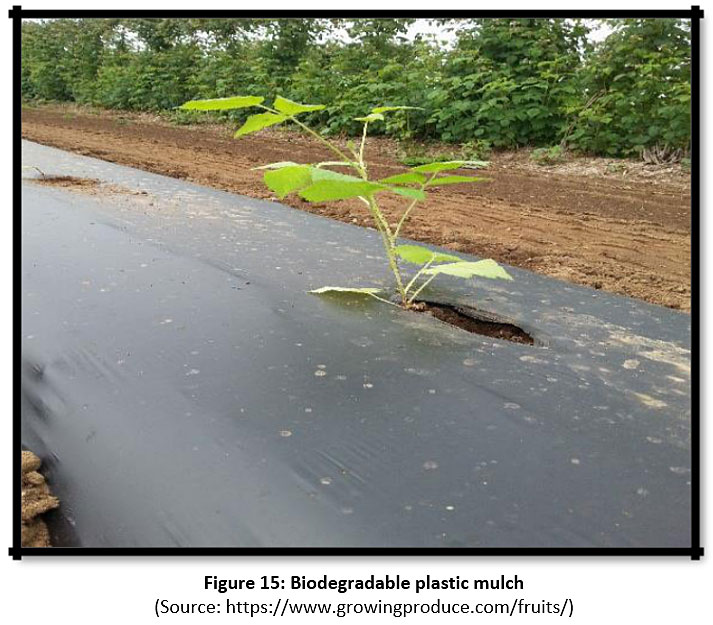 |
Figure 15: Biodegradable plastic mulch Click here to view Figure |
Advantages of Plastic Mulching
It is totally impervious to water. Plastic mulching reduces rate of evaporation, increases moisture holding capacity, stops the rise of water containing salts, lessens the leaching of plant nutrients, prevent germination of weeds, repel insects and pests, increases the germination speed, maintains soil structure and reduces soil erosion.
Disadvantages of Plastic Mulching
They are less economical as compared to organic mulches. Black mulch film can develop the risk of scorching of early plants because of increased temperature. Movement of agricultural machinery in mulched field is difficult. Plastic mulching is toxic for animals (Srinidhi and Nazareth, 2018). It can hinder development of roots of the succeeding crop (Schonbeck, 1995). If plastic mulching in soil continues for 5 to 20 successive years it can result into 122 to 146% increase in salt content of top soil (Liu et al., 2014).
Selection of Plastic Mulches
The assortment of plastic mulches be subject to environmental conditions and main characteristics of mulching.
Table 1: Selection of appropriate plastic mulch
|
Rainy season |
Perforated mulch |
|
Orchard and plantation |
Thicker mulch |
|
Early germination |
Thinner film |
|
Soil solarisation |
Thin transparent film |
|
Weed control through solarisation |
Transparent film |
|
Weed control in cropped land |
Black film |
|
Sandy soil |
Black film |
|
Saline water use |
Black film |
|
Summer cropped land |
White film |
|
Insect repellent |
Silver colour film |
Source: (Sharma and Bhardwaj, 2017)
Aspects of Plastic Mulching
Application of plastic mulching material in modernize agriculture is termed as plasticulture, which is being used progressively for the production of fruits and vegetables (Kader et al. 2017b, Ibarra-Jiménez et al., 2011; Kasirajan and Ngouajio, 2012). Approximately 10 lakh ton of plastic is used as plastic mulch in agriculture across the globe every year (Yu et al., 2018). China is the biggest user of plastic mulch, around 40% of the world, in the country followed by Japan and South Korea (Daryanto et al. 2017; Ihuoma and Madramootoo, 2017). Plastic mulching has boosted the production of maize and wheat with the amount of nearly 33.6% and 33.1% respectively in China (Chen et al., 2014).
Effect of mulching on soil water conservation
Mulching is very helpful in conserving soil moisture in dryland areas after reducing the rate of evaporation (Yang et al. 2015; Kader et al. 2017a; Chakraborty et al. 2008; Zribi et al. 2015). Plastic mulch having moisture barricade properties does not allow escape of soil moisture, because the moisture evaporates beneath the mulch film, after condensing, gone back into the soil as water droplets. Thus, moisture is conserved for many days, that’s why increases the irrigation period and lessens the irrigation demand during period of crop cultivation (Kader et al. 2017b). Plastic mulching is much effective as compared to straw mulching for soil water conservation (Li et al. 2013). Reducing rate of surface evaporation for soil moisture conservation and diminishing soil erosion is the foremost asset of mulching techniques (Qin et al. 2016). Mechanism of transferring heat and water is very important for effective use of mulching material (Li et al. 2018; Kader et al. 2019). Selection of suitable mulching material is very important to lessen the irrigation frequency in crop cultivation (Chalker-Scott, 2007). Mulches have the ability to retain moisture in the root zone of plants (Smith et al., 1997; Koski and Jocobi, 2004; Duryea et al., 1999), consequently, water may be accessible for an extended period for the plants (Pakdel, 2010). Soil covered with mulches has lesser rate of evaporation in comparison to the bare soil (Singer and Martin, 2008; Steward et al., 2003; Iies and Dosmann, 1999; Duryea et al., 1999).
Effect of mulching on control of weeds
In summer season, weeds available in bare soil not covered with mulches can increase the rate of evapotranspiration by 25% (Chalker-Scott, 2007). Organic mulches conquer weeds and burry the seeds of weeds to stop its germination (Koshki and Jocobi, 2004; Duryea et al., 1999; Pakdel, 2010), and if any weeds grow by mistake due to its loose texture, then pulling out of weed is an easy task.
Effect of mulching on soil temperature
Organic and inorganic mulches both are very useful in regulating temperature in root zone of the plants (Singer and Martin, 2008; Koshki and Jocobi, 2004; Steward et al., 2003). In nonliving inorganic mulches the temperature of soil below it at a depth of 10 cm is around 2.5 °C higher than the soil at a depth of 10 cm beneath organic mulches. Organic mulches restrict the diffusion of heat energy into the soil which results in decreasing soil temperature (Singer and Martin, 2008). While using plastic mulches, the temperature of soil upsurges approximately 6 °C and 4 °C at depths of 5 cm and 10 cm respectively, while wheat straw mulch upsurges temperature of soil by approximately 2.3 °C (Ramakrishna et al., 2006).
Effect of mulching on soil properties
Compaction of soil is very much common in municipal areas. In this esteem, compression by rainfall, which is due to absence of shield of the soil, is not much understandable (Chalker-Scott, 2007). Mulches are capable to advance the condition of soil for a long period. After using bark mulch obtained from forest tress during 8 years amplified porosity and lessened bulk density of the soil (Oliveira and Merwin, 2001).
Effect of mulching on plant’s growth
Mulches can enhance germination and growth of plants in the soil (Smith et al., 1997; Koshki and Jocobi, 2004; Skroch et al., 1992). Mulches can improve establishment of roots, germination of plants and survival of transplanted plants. In organic mulching, there is better growth and density of the plant root system as compared to naked soil and plastic mulching (Chalker-Scott, 2007).
Discussions
It is proved that more favorable soil environment can be obtained by use of mulching to upsurge the harvest of fruits and vegetables (Kumar et al., 2018). Among all the mulches, soil moisture conservation is higher in rice straw mulch and black plastic mulch as compared to soil without mulch. Drop in competition of weeds with the crop and its environment in soil organic carbon were resulted in better growth and yield of vegetables. Based on benefit cost ratio, Soil treatment with rice straw mulches were most economical, followed by black much films (Kumar et al., 2018). Black plastic mulch playing very precious role in the production of various fruits and vegetables. It also increases the habit of early maturity in fruits and vegetables by increasing the temperature of soil, conserving the soil moisture and reducing the use of pesticides. Also, it can protect the soil from leaching of nutrients to root zone in the season of heavy precipitation. Earlier plastic mulches do not comprised of degradation ability but now a days so many degradable plastic mulches such as biodegradable plastic mulches, photodegradable plastic mulches etc., have been developed and they have better ability to deteriorate itself into the soil after the life span of mulches, without adding any negative impact to the soil and that leads to eliminate the purpose of removal of waste mulches that are designed to be fused into the soil profile (Hannan et al., 2012). For the purpose of control of soil sodicity and salinity, organic and inorganic both mulches are more effective than the unembellished soil. (Ramon et al., 2014). It has seen that, use of plastic mulching expressively increased the yield of crop and water use efficiency by 24.32% and 27.63% respectively (Gao et al., 2018). Plastic mulching had also increased the yield and water using capacity of potato crop noticeably by 30.62% and 30.34% respectively (Li et al., 2018). Yield of crops and water use efficiency are greatly influenced by method of mulching, type of crop and color of mulch film. Black mulches are more favorable to increase the production and water use efficiency of crop in low rainfall regions (Gao et al., 2018). The yield of tomato reported was highest under plastic mulches followed by newspaper mulching, rice-straw mulches and biodegradable plastic mulches (Divya and Sarkar, 2019).
Table 2: List of crops showing high yield after using plastic mulch
|
Vegetable crop |
Orchard crop |
|
Cabbage |
Pomegranate |
|
Cauliflower |
Lemon |
|
Capsicum |
orange |
|
Tomato |
Banana |
|
Brinjal |
Peach |
|
Chilli |
Guava |
|
Okra |
Papaya |
|
Potato |
Apricot |
|
|
Grapes |
(Source: https://agricultureguruji.com/mulching/)
Table 3: Increase in Yield of Fruit Crops through Plastic Mulching
|
Crop |
Yield (T/ha) |
|
Increase in |
|
|
Un-mulched |
Mulched |
yield (%) |
|
Banana |
53.99 |
73.32 |
33.95 |
|
Papaya |
73.24 |
120.29 |
64.24 |
|
Ber |
7.02 |
8.92 |
27.06 |
|
Mango |
4.93 |
7.16 |
45.23 |
|
Guava |
18.36 |
23.12 |
25.93 |
|
Litchi |
111.0 |
125.0 |
12.61 |
|
Pineapple |
10.25 |
11.75 |
14.63 |
(Source: NCPAH, New Delhi (National Committee on Plasticulture Applications in Horticulture)
Table 4: Increase in Yield of Vegetable Crops through Plastic Mulching
|
Crop |
Yield (T/ha) |
|
Increase in |
|
|
Un-mulched |
Mulched |
yield (%) |
|
Bitter Gourd |
20.12 |
25.63 |
27.39 |
|
Tomato |
69.10 |
94.85 |
37.26 |
|
Brinjal |
36.73 |
47.06 |
28.12 |
|
Chilli |
16.79 |
19.71 |
17.39 |
|
Okra |
6.91 |
8.56 |
23.88 |
|
Cabbage |
14.3 |
19.9 |
39.16 |
|
Broccoli |
15.64 |
25.14 |
60.74 |
|
Cauliflower |
18.58 |
25.02 |
34.66 |
(Source: NCPAH, New Delhi (National Committee on Plasticulture Applications in Horticulture)
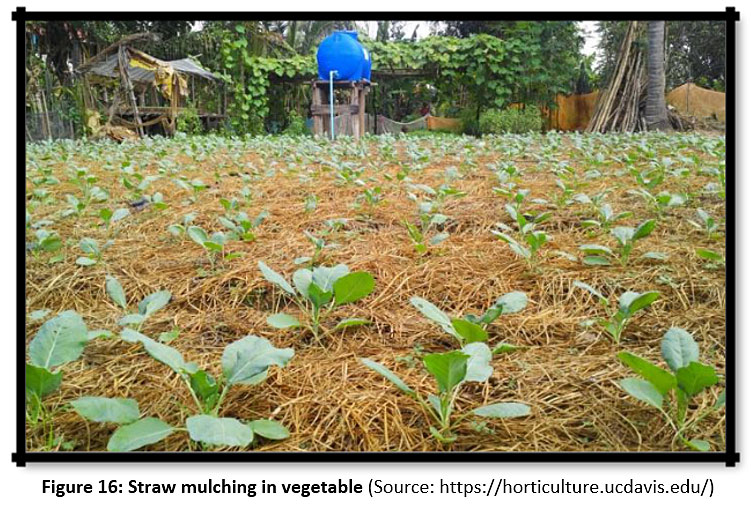 |
Figure 16: Straw mulching in vegetable Click here to view Figure |
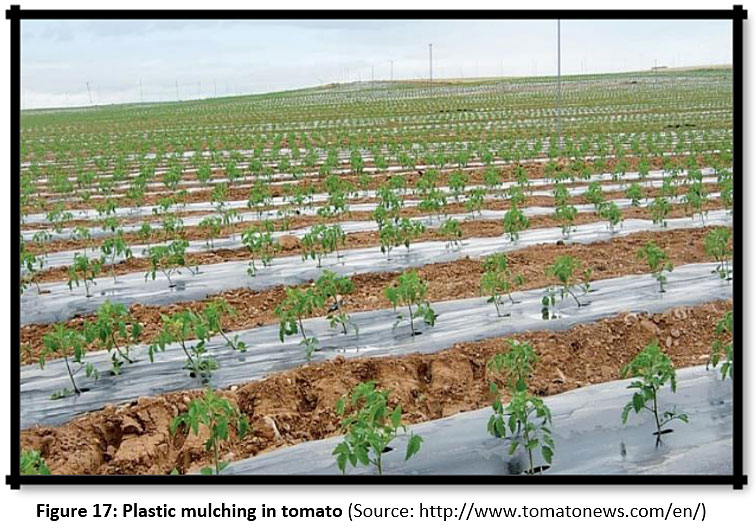 |
Figure 17: Plastic mulching in tomato Click here to view Figure |
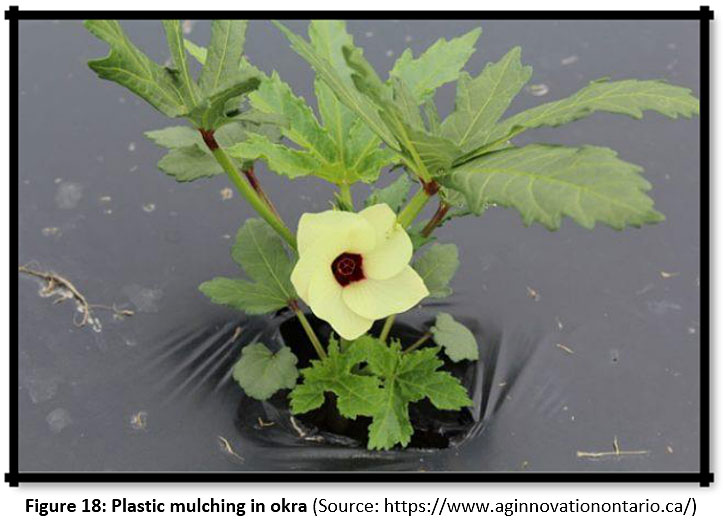 |
Figure 18: Plastic mulching in okra Click here to view Figure |
Conclusions
Mulching, now a days, has become a very useful practice to conserve the soil water and increase the production of various agricultural commodities generally in low rainfall regions. Mulching can increase the moisture holding capacity of soil, lessen the evapotranspiration, reduce the weed growth and moderate the soil temperature. Mulching can increase the water use efficiency of soil, reduce the leaching of nutrients, diminish the soil erosion and increase the infiltration capacity of soil. Mulching can also be useful in beautification of landscape, farmlands and gardens. The selection of mulch materials basically depends on durability, availability and cost-effectiveness. Yields of crops may not essentially increased directly by application of mulching, but more land can be cultivated with the available amount of water and thus overall cultivation of crops can be increased. Organic and inorganic mulches both are very useful in regulating temperature in root zone of the plants. Plastic mulching can readily improve the various soil properties like soil moisture, soil temperature, soil nutrients, bulk density and cumulative stability. There are also various types of plastic mulches are available in market such as black, red, blue, white brown colored mulches, transparent mulches, reflective silver mulches, metallized mulches and infra-red transmitting mulches, which all have different benefits. Yield and growth of plant are also certainly influenced by the use of plastic mulches due to the amendment of soil microclimate. In spite of many advantages, plastic mulching has also some disadvantages such as high initial cost, more moisture accumulation, soil salinity and disposal of plastic materials but these drawbacks are resolved after the introduction of biodegradable and photodegradable mulches, which can efficiently increase the productivity and control the pollution of soil atmosphere. So, it can be concluded that the use of both organic and inorganic mulches is very useful for increasing the agricultural production with least usage of irrigation water, providing additional nutrients to soil and protecting the soil health from various limiting factors.
Acknowledgement
Authors are grateful to the Department of Agricultural Engineering, North Eastern Regional Institute of Science and Technology and Department of Farm Machinery and Power Engineering, College of Agricultural Engineering and Technology, Anand Agricultural University, Godhara, Gujarat, for providing the support and valuable suggestions for bringing this paper.
Funding
The author(s) received no financial support for the research, authorship, and/or publication of this article.
Conflict of Interest
The authors do not have any conflict of interest.
References
- Chakraborty D, Nagarajan S, Aggarwal P, Gupta V. K, Tomar R. K, Garg R. N, Sahoo R. N, Sarkar A, Chopra U. K, Sarma K. S. S, Kalra N. Effect of Mulching on Soil and Plant Water Status and the Growth and Yield of Wheat (Triticum Aestivum L.) in a Semi-Arid Environment. Agric Water Manag.2008; 95:1323-1334.
- Chalker-Scott, L. Impact of Mulches on Landscape Plants and The Environment, A Review. Journal of Environmental Horticulture.2007; 25:239-249.
- Chen B, Liu E, Mei X, Yan C, Garre S. Modelling Soil Water Dynamic in Rainfed Spring Maize Field with Plastic Mulching. Agric Water Manag.2018; 198:19-27.
- Chen L. J, Feng Q, Li F. R, Li C. S. A Bidirectional Model for Simulating Soil Water Flow and Salt Transport Under Mulched Drip Irrigation with Saline Water. Agric Water Manag.2014; 146:24-33.
- Daryanto S, Wang L, Jacinthe P. A. Can Ridge-Furrow Plastic Mulching Replace Irrigation in Dryland Wheat and Maize Cropping Systems? Agric Water Manag.2017; 190:1-5.
- David O. The Garden Guy – A Seasonal Guide to Organic Gardening in the Desert Southwest. Poco Verde Landscape.2002.
- Dilip K. G., Sachin S. S, Rajesh K. Importance of Mulch in Crop Production. Indian J. Soil Cons.1990; 18:20-26.
- Divya, V. U, Sarkar, N. C. Plastic Mulch Pollution and Introduction of Biodegradable Plastic Mulches: A Review. Agricultural Reviews.2019; 40(4):314-318.
- Duryea M. L, Huffman J. B, Jeffery E. R, Osbrink W. Will Subterranean Termites Consume Landscape Mulches? Journal of Arboriculture.1999; 25; 143-150.
- Gao H, Yan C, Ding Q. L. W, Chen B, Li Z. Effects of plastic mulching and plastic residue on agricultural production: A meta-analysis. Sci of the Tot Envi. 2019; 651:484– 492.
- Gonzalez-dugo V, Zarco-tejada PJ, Fereres E (2014) Applicability and limitations of using the crop water stress index as an indicator of water deficits in citrus orchards. Agric For Meteorol. 198–199:94–104.
- Hannan, J. M. Black Degradable Plastic Mulch Evaluation. Iowa State Research Farm Progress Reports.2012; 30.
- Huang Z, Xu Z, Chen C. Effect of Mulching on Labile Soil Organic Matter Pools, Microbial Community Functional Diversity and Nitrogen Transformations in Two Hardwood Plantations of Subtropical Australia. Appl Soil Ecol.2008; 40:229-239.
- Ibarra-Jiménez L, Lira-Saldivar R. H, Valdez-Aguilar L. A, Del R. J. L. Colored Plastic Mulches Affect Soil Temperature and Tuber Production of Potato. Acta Agric Scand Sect B Soil Plant Sci.2011; 61:365-371.
- Ihuoma S. O, Madramootoo C.A. Recent Advances in Crop Water Stress Detection. Comput Electron Agric.2017; 141:267-275.
- Iies, J. K, Dosmann M. S. Effect of Organic and Mineral Mulches on Soil Properties and Growth of Fairview Flame Red Maple Trees. Journal of Arboriculture.1999;25:163-167.
- Jack C. V., Brind W. D, Smith R. Mulching Tech. Comm. No. 49, Commnwealth Bulletin of Soil Science.1955.
- Kader M. A, Nakamura K, Senge M, Mojid M. A, Kawashima S. Numerical Simulation of Water and Heat Flow Regimes of Mulched Soil in Rain-Fed Soybean Field in Central Japan. Soil Tillage Res.2019; 191:142-155.
- Kader M. A, Senge M, Mojid M. A, Ito K. Recent Advances in Mulching Materials and Methods for Modifying Soil Environment. Soil Tillage Res.2017a; 168:155-166.
- Kader M. A, Senge M, Mojid M. A, Nakamura K. Mulching Type-Induced Soil Moisture and Temperature Regimes and Water Use Efficiency of Soybean Under Rain-Fed Condition in Central Japan. Int Soil Water Conserv Res.2017c; 5:302-308.
- Kader M. A, Senge M, Mojid M. A, Onishi T, Ito K. Effects of Plastic-Hole Mulching on Effective Rainfall and Readily Available Soil Moisture Under Soybean (Glycine Max) Cultivation. Paddy. Water Environ.2017b; 15:659-668.
- Kasirajan S, Ngouajio M (2012) Polyethylene and Biodegradable Mulches for Agricultural Applications: A Review. Agron Sustain Dev.2012; 32:501-529.
- Koski, R, Jacobi W. R. Tree Pathogen Survival in Chipped Wood Mulch. Journal of Arboriculture.2004; 30:165-171.
- Kumar V, Prasad S, Kumar D, Kumar J, Shahi B, Singh S. K, Kumar M. Effect of Straw and Plastic Mulching on Soil Environment, Crop Performances and Profitability of Brinjal (solanum melongena l.) in Semi Arid Region of Bihar. Bull Env Pharmacol Life Sci.2018;8(1):162-167.
- Larentzaki E, Plate J, Nault B. A, Shelton A. M. Impact of Straw Mulch on Populations of Onion Thrips (Thysanoptera: Thripidae) in Onion. J Econ Entomol.2008; 101:1317-1324.
- Li C, Wang C, Wen X, Qin X, Liu Y, Han J, Li Y, Liao Y, Wu W. Ridge -Furrow with Plastic Film Mulching Practice Improves Maize Productivity and Resource Use Efficiency Under the Wheat-Maize Double Cropping System in Dry Semi-Humid Areas. F Crop Res.2017; 203:201–211.
- Li R, Hou X, Jia Z, Han Q, Ren X, Yang B. Effects on Soil Temperature, Moisture, and Maize Yield of Cultivation With Ridge And Furrow Mulching in The Rainfed Area of The Loess Plateau. China. Agric Water Manag.2013; 116:101-109.
- Liu E. K, He W. K, Yan C. R. ‘White Revolution’ to ‘White Pollution’-Agricultural Plastic Film Mulch. China Envi Res.2014; 9.
- Oliveira M. T, Merwin L A. Soil Physical Conditions in a New York Orchard After Eight Years Under Different Groundcover Management Systems. Plant and Soil.2001; 234:233-237.
- Pakdel P. Studying the Effects of Mulch Type and its Thickness on Soil Temperature, Moisture and Growth Characteristics of Several Plants Used in Urban Green Spaces. MSc. Thesis. Ferdowsi University of Mashhad. In Persian.2010.
- Patil S. S, Kelkar T. S, Bhalerao S. Mulching: A Soil and Water Conservation Practice. Res Jour of Agri and Fore Sci.2013; 1:26–29.
- Prem M, Swarnkar R, Ranjan P, Baria a. V. In Situ Moisture Conservation Through Tillage Practices. Multi In Sci.2017;7(23).
- Qin S, Li S, Kang S, Du T, Tong L, Ding R. Can The Drip Irrigation Under Film Mulch Reduce Crop Evapotranspiration and Save Water Under The Sufficient Irrigation Condition? Agric Water Manag.2016; 177:128–137.
- Qin S, Li S, Yang K, Hu K. Can Plastic Mulch Save Water at Night in Irrigated Croplands? J Hydrol.2018; 64:667–681.
- Qin W, Chi B, Oenema O. Long-Term Monitoring of Rainfed Wheat Yield and Soil Water at The Loess Plateau Reveals Low Water Use Efficiency. PLoS One.2013; 8(11)
- Qin W, Hu C, Oenema O. Soil Mulching Significantly Enhances Yields and Water and Nitrogen Use Efficiencies of Maize and Wheat: A Meta-Analysis. Sci Rep.2015; 5.
- Ramakrishna A, Tam H. M, Wani S. P, Lomg T. D. Effect of Mulches on Soil Temperature, Moisture, Weed Infestation and Yield of Groundnut in Northern Vietnam. Field Crops Research.2006; 95:115–125.
- Ramón A, Eva T. M, Ignacio C. Effectiveness of inorganic and organic mulching for soil salinity and sodicity control in a grapevine orchard drip-irrigated with moderately saline waters. Span Jour of Agri Res.2014;12(2):501-508.
- Ranjan P, and Prem M. Schmutzdecke- A Filtration Layer of Slow Sand Filter. Int J Curr Microbiol App Sci.2018;7(7):637-645.
- Ranjan P, Patle G. T, Prem M, Solanke K. R. Organic Mulching- A Water Saving Technique to Increase the Production of Fruits and Vegetables. Curr Agri Res.2017;5(3).
- Ravinderkumar, Srivatsava B. K. Influence of Different Mulches on Flowering and fruit Setting of Winter Tomato. Crop Res.1998; 12:174-176.
- Schonbeck, M.W., (1995). Mulching practices and innovations for warm season vegetables in Virginia and neighbouring states. 1. An informal survey of growers VA Assoc. Biol. Farming, Blacksburg, VA, 24 pp.
- Sharma R, Bhardwaj S. Effect of mulching on soil and water conservation -A review. Agri Revi.2017; 38(4):311-315.
- Singer C. K, Martin C. A. Effect of Landscape Mulches on Desert Landscape Microclimates. Arbori and Urb Fores.2008; 34:230-237.
- Skroch W. A, Powel M. A, Bilderback T. E, Henry P. H. Mulches: Durability, Aesthetic Value, Weed Control, and Temperature. Jour of Envi Horti.1992; 10:43-45.
- Smith D. R, Gilliam C. H, Edwards G. H, Eakes D. J, Williams J. D., 1997. Recycled Waste Paper as a Landscape Mulch. Jour of Envi Horti.1997; 15:191- 196.
- Srinidhi A, Nazareth D. (2018). Beating plastic pollution in agriculture – World Environment Day special. Handbook of biodegradable polymers. Harwood Academic, Amsterdam:473–511.
- Steinmetz Z, Wollmann C, Schaefer M, Buchmann C, David J, Troger J, Munoz K, Fror O, Schaumann G. E. Plastic Mulching in Agriculture Trading Short Term Agronomic Benefits for Long-Term Soil Degradation? Sci Total Environ.2016; 550:690–705.
- Steward L.G, Sydnor T.D, Bishop B. The Ease of Ignition of 13 Landscape Mulches. Jour of Arbori.2003; 29:317-321.
- Sun H, Shao L, Liu X, Miao W, Chen S, Zhang X. Determination of Water Consumption and The Water-Saving Potential of Three Mulching Methods in a Jujube Orchard. Eur J Agron. 2012; 43:87–95.
- Tarara J. M. Microclimate modification with plastic mulch. Hort Science.2000; 35:169-180.
- Telkar S.G, Singh A. K, Kant K, Solanki S. P. S, Kumar D. Types of Mulching and their uses for dryland condition. Biomolecule Reports.2017;17(6):1-4.
- Van Derwerken, J. E, Wilcox, L. D. (1988). Influence of Plastic Mulch and Type and Frequency of Irrigation on Growth and Yield of Bell Pepper. Horticultural Science.1988;23: 985-988.
- Yang N, Sun Z, Feng L, Zheng M, Chi D. Plastic Film Mulching for Water Efficient Agricultural Applications and Degradable Films Materials Development Research. Mater Manuf Process.2015;30(2):143-154.
- Yu Y. Y, Turner N. C, Gong Y. H, Li F. M, Fang C, Ge L. J, Ye J. S. Benefits and Limitations to Straw and Plastic Film Mulch on Maize Yield and Water Use Efficiency: A Meta-Analysis Across Hydrothermal Gradients. Eur J Agron.2018; 99:138-147.
- Zribi W, Aragues R, Medina E, Faci J. M. Efficiency of inorganic and organic mulching materials for soil evaporation control. Soil Tillage Res.2015; 148:4 0-45






